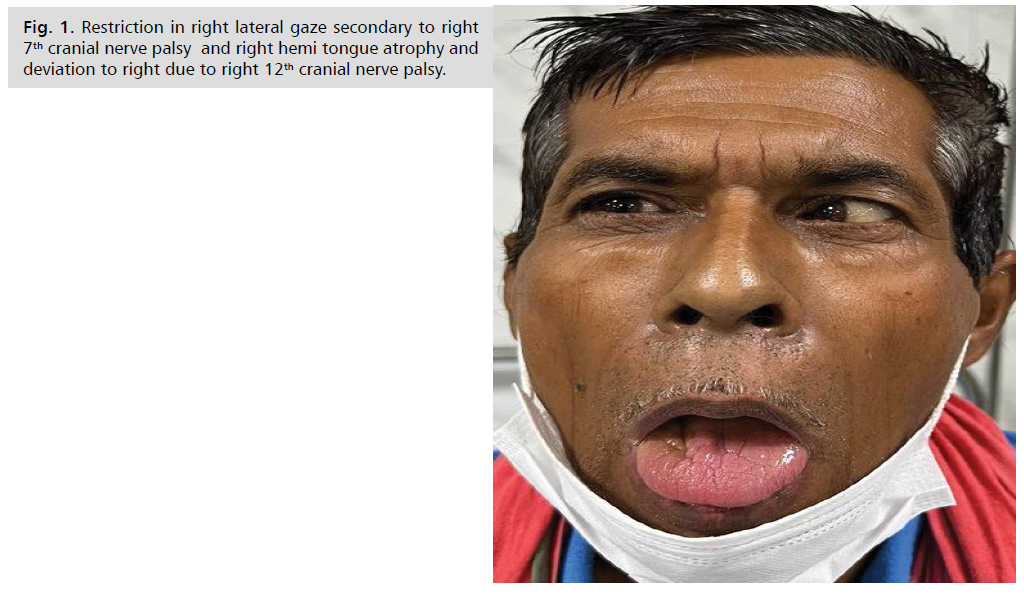Case Report - (2022) Volume 13, Issue 7
Concomitant sixth and twelfth cranial nerve palsy: The godtfredsen syndrome - A rare combination
Ajay Emani*,
Kulshreshtha D,
Singh AK,
Maurya PK and
Qavi A
Department of Neurology, Dr Ram Manohar Lohia Institute of Medical Sciences, Lucknow, Uttar Pradesh, India
*Correspondence:
Ajay Emani, Department of Neurology, Dr Ram Manohar Lohia Institute of Medical Sciences, Lucknow, Uttar Pradesh,
India,
Email:
Received: 10-Jul-2022, Manuscript No. ipjnn-22-12861;
Editor assigned: 12-Jul-2022, Pre QC No. P-12861;
Reviewed: 18-Jul-2022, QC No. Q-12861;
Revised: 24-Jul-2022, Manuscript No. R-12861;
Published:
30-Jul-2022
Abstract
Godtfredsen syndrome is a rare clinical manifestation of concomitant
sixth and twelfth cranial nerve palsies. It was first reported by
Eric Godtfredsen in 1946 relating to metastatic nasopharyngeal
carcinoma. Modern imaging modalities have been able to reveal
that clival lesions are most commonly associated with this rare
presentation. Our case highlights the importance of identifying this
syndrome in an appropriate clinical setting for a prompt diagnosis
and management.
Keywords
Cranial nerve palsy; Sixth and twelfth cranial nerve
palsies; Clivus metastasis; Godtfredsen Syndrome
Case Report
A 50-year-old man presented with slurring of speech and
diplopia of six months duration. There was no headache or
features of raised intracranial pressure [1]. There were no
suggestions of associated systemic symptoms or any other
cranial nerves being involved. There was no diurnal variation
or fluctuations in symptoms. Clinical examination showed
right abducens and hypoglossal nerve palsy with no other
deficits (Fig. 1). He was evaluated elsewhere with normal
blood investigations and computed tomography (CT) scan
of the brain [2-4]. Repetitive nerve stimulation testing
for neuromuscular junction disorders was normal. With
concomitant ipsilateral sixth and twelfth cranial nerves
being involved, Godtfredsen syndrome was considered and
Magnetic resonance imaging (MRI) of the brain showed
an extensive, irregular, multilobulated, heterogeneously
enhancing mass lesion involving the clivus, petrous part
of temporal bone and the body of C1 vertebral body on
the right side, suggestive of metastasis (Fig. 2). Further
evaluation for the same revealed an elevated serum prostate
specific antigen levels and he was referred to the urologist
with a suspicion of prostate malignancy [5].

Fig 1:Restriction in right lateral gaze secondary to right 7th cranial nerve palsy and right hemi tongue atrophy and deviation to right due to right 12th cranial nerve palsy.

Fig 2:MRI brain A) Sagittal T2WI showing abnormal signal in the clivus; B) Contrast enhanced MRI showing extensive, heterogeneously enhancing lesion involving the clivus and petrous temporal bone on the right side.
Discussion and Conclusion
Patients with multiple cranial nerve palsies are a
frequent admission in neurology clinics and require
extensive and urgent work up for timely management.
Abducens nerve palsy has been emphasised from early
medical school days as a false localising sign and is
considered in many instances before the complete work
up of a case. However, the unusual combination of sixth
and twelfth cranial nerve involvement with the sparing of
other nerves is rarely seen. Godtfredsen first described this
combination in cases of nasopharyngeal carcinoma, in his
discussion on the ophthalmo-neurological symptoms of
nasopharyngeal tumours. Apart from the combination of
multiple cranial nerve palsies in nasopharyngeal lesions,
he emphasised that, the occurrence of ophthalmoplegia
with tongue weakness is pathognomic of malignant
nasopharyngeal tumours, with trigeminal neuralgia seen in
a majority of cases. This rare combination is thought to
be a result of intracranial growth of primary tumour and
lymphogenous metastasis to retrophryngeal lymph glands,
lying off the hypoglossal canal and compressing the twelfth
cranial nerve. Five patients reported by Keane, et al., with
Godtfredsen syndrome, had clival chordoma, metastasis
from prostate, pancreas and ovary and a self-limited cranial
polyneuropathy in one patient. Clival metastasis is extremely
rare of all intracranial tumours and represents 0.42% of
skull base tumours. Prostate, thyroid, kidney, lungs, skin, bone, liver and gastric malignancies have been associated
with clival lesions. Retroclival subdural hematoma has also been reported to cause this rare association of concomitant
6th and 12th cranial nerve palsy.
REFERENCES
- O’Boyle JE, Gardner TA, Oliva A, et al. Sixth nerve palsy as the initial presenting sign of metastatic prostate cancer. A case report and review of theliterature. J Clin Neuroophthalmol. 1992;12(3):149-153.
Google Scholar, Indexed at
- Godtfredsen E. Ophthalmo-neurological symptoms in connection with malignant nasopharyngeal tumours. Br J Ophthalmol. 1947;31(2):78-100.
Google Scholar, Crossref, Indexed at
- Keane JR. Combined VIth and XIIth cranial nerve palsies: a clival syndrome. Neurology. 2000;54(7):1540-1541.
Google Scholar, Crossref, Indexed at
- Roberto P, Giovanni S, Francesco D, et al. Clivus metastases: report of seven patients and literature review. Acta Neurochir. 2009;151(4):291-296.
Google Scholar, Crossref, Indexed at
- Amalnath SD. Teaching neuroimages: Godtfredsen syndrome due to retroclival subdural hematoma. Neurology. 2018;91(10):e999-e1000.
Google Scholar, Crossref, Indexed at







